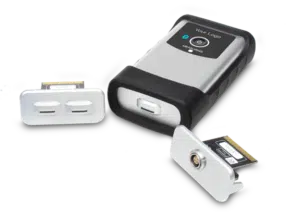Developing your own electrochemical sensor and reader
Electrochemistry has a wide range of applications. Measuring heavy metal pollution in water, or taking a point-of-care test at your doctor and receiving the results within minutes or even seconds.
To get an electrochemical sensor and reader from research to sale, you will have to pass several phases. This article will tell you about these phases. There are many pitfalls to be avoided as the lessons learned will show you. Get to know more about the planning and costs of an electrochemical reader, and see how PalmSens can help you.
11 Typical phases of an electrochemical sensor project
Developing a (bio)sensor that shows promising results during your PhD is not a finished product. If you are interested in going to market with your sensor you will have to establish a development roadmap with clear milestones and a demand and wish list for the Minimum Viable Product (MVP).
A typical development roadmap for an electrochemical sensor has the following 11 phases:
- Develop a first stable (bio)sensor
- Benchmark biosensor against established technologies
- Create first prototype reader with basic software/app
- Test sensor and reader in the field, get feedback from the users
- Implement findings and update the demand and wish list for the minimal viable product
- Execute large scale sensor testing in the lab (avoid manual pipetting!)
- Choose the electronics and housing for the reader
- Develop an easy-to-use software app (avoid feature creep)
- Apply for regulatory approval
- Setup manufacturing and sales organization
- Sell your device
This article won’t dive into each phase, but it is important to create a planning based on these phases. Besides planning, each phase has its own peculiarities and pitfalls. Read our lessons learned on how to avoid these pitfalls.
7 Lessons learned during the development of an electrochemical sensor and reader
At PalmSens, we get to speak to a wide variety of enthusiastic entrepreneurs, electrochemists and engineers, from small scale startups to large scale multinationals. This is what we learned:
Focus. The holy grail within the field of electrochemistry is reproducibility. Developing a biosensor which gives the same result over and over again takes in our experience 5 to 7 years. The core value of your company is the biosensor. This is also where all the IP is created. Make sure your sensor works well on a large scale test in the field. Fine-tuning the quality of the biosensor should have the highest priority in the company.
Set clear boundaries. Keep in mind, for a scientist the work is never finished. The sensor can always be improved. It is important to set clear boundaries before you are going to start. If you can measure the minimum threshold which is good enough to go to market, don’t lose a lot of time in trying to optimize the biosensor a little bit further. If the sensor works it works. Imagine that just having a working sensor, is already a product that you can commercialize.
Use what is already developed. Although you could design your own reader, you probably don’t want to master the required electronics, firmware, mechanical and software skills. It literally takes years to develop and produce your own reader that can be scaled to high volumes. PalmSens can provide market-ready instruments with your logo and adapted to your sensor on very short notice. This saves you both money and precious (development) time, which you can use to put your product earlier on the market. Don’t reinvent the wheel and use what is already developed.
Be ambitious and realistic. It is understandable to be enthusiastic about the planning of your new product. Your product will change the lives of many people. But no one ever developed a sensor, did field tests, got approval and started selling worldwide within a year. So please be realistic with your planning and required budget. Improve your planning with focus, and use what is already developed by others. Don’t be afraid to ask for help.
Do you have the entrepreneurial spirit? With a great idea, you can start a company. Electrochemists and engineers are great at developing a product. To make a company a success, you will need sales, production, operations, finance, quality control, finding investors, etc. Who will take on this responsibility? Make sure you have an entrepreneurial spirit in your team.
Join forces with a known distributor. There are many conservative industries which are difficult to persuade to use innovative products. If you are able to find a distribution company that is already established in the market you should definitely join forces. The distributor can open doors you can’t. A renowned distributor can give you the authority you need and help you with providing support to the clients.
Keep going. When creating your own product, you will encounter many setbacks. Your sensor might need a bit more time to develop, your favorite housing producer just has gone bankrupt or you simply found this list too late. Setbacks are normal, think of your end goal, communicate in a transparent way with your investors and partners and keep trying new solutions. Don’t give up.
Need advice on how to bring your electrochemical project to a success? We can have a meeting to discuss your problems or questions.
Planning electrochemical reader
The (bio)sensor development will take most of your time. In general you would need 5 to 7 years of research. As soon as you have a working sensor, you will need a dedicated reader for your application. Building your own reader can take many years as well.
Luckily, there is a way to speed up your development. You can order OEM potentiostat modules and build your own instrument or a customized market-ready solution which is available on very short notice. The reader will also need software to perform measurements. To save time, you can use PalmSens templates from the Software Development Kit. Reusing established code in combination with a market-ready solution, means your electrochemical reader can be finished within a 3 to 12 months time frame.
Before you start developing it is important to have a clear understanding of what is required to get regulatory approval.
Regulatory approval for electrochemical reader
There are different kinds of approvals and declarations that you might need. What you need depends on the use case of your reader and how dangerous that is to human health. Measuring lead in water for example, is loosely regulated, whereas measuring an infectious disease in blood is highly regulated.
Medical devices such as Point-of-care devices which measure for example via a drop of blood, are regulated in the US by the FDA. FDA approval can take 6 months to several years. External advisors can help you apply for FDA approval. Within the EU all devices need to have a CE declaration. The CE declaration has to state the standards to which the electrochemical reader has been tested.
For a medical device for example it is useful to follow the IEC60601 and the IEC 61010-2-101 guidelines for IVD medical electrical equipment and have a quality management system as specified by ISO 13485.
Research instruments from PalmSens have a CE declaration for laboratory use, which are located in the manual. This means the instruments have been tested for radiated immunity and radiated emission. If you will be active in the European market, you will need your own CE declaration tailored for the market you want to enter.
Unit costs of an electrochemical reader
In the world of electronics the main determination of costs are the volumes ordered. The price per reader drops rapidly when the volume increases. If you are in a high-end market the price of the reader is not the deciding factor for end customers. Clients will look at the total costs of ownership. If you are in a high volume market, the price of the reader will be more important as it can be an entry barrier. Most of our OEM clients work according to the razor-blade strategy. The razor (reader) is (almost) for free, but the blades (disposable biosensors) are where the turnover is generated.
Develop your own electrochemical reader
Some companies are interested in developing their own reader from scratch. In practice it will take many man-years to develop a custom reader that will give you all the functionality you require. Let’s assume you develop the electrochemical reader internally with five persons working for four years. That is a total of 20 man-years, which in Europe cost around 2 million euro. Let’s assume that the market-size is around 1000 readers, that means each reader has 2000 euro of fixed costs, plus the production costs.
Use electrochemical modules
By using proven and tested research-grade electrochemical modules, developers can concentrate on the other hardware and software of the reader that needs to be developed. This reduces the development time to 1 to 2 years, with three persons. Let’s say a total of 5 man-years, which in Europe costs around 0.5 million euro. Assuming you need a 1000 readers, that means each reader has a 500 euro of fixed costs, plus the production costs and the module costs.
Use electrochemical market-ready solution
Many companies don’t have the time, money or skills to develop their own electrochemical reader. And why would you, if you can order one that is available right now? All you have to do is create your own application using the templates Software Development Kit. The unit costs are relatively low compared to developing your own reader. Ask PalmSens for more information.
Contact Us Discover OEM potentiostat modules and instruments
How can PalmSens help with the development of an electrochemical sensor and reader?
PalmSens can help in multiple ways.
First with the sensor development: PalmSens offers both the sensors, research instruments and adapters to discover which sensor is best suited for your purpose. PalmSens partners with sensor manufacturers who can scale-up together with you.
For the development of the reader of the biosensor, PalmSens provides market-ready solutions. All you need is a custom application using the Software Development Kit and you are done. Alternatively, if you need for example a custom multi-channel device, PalmSens provides calibrated and proven electrochemical modules.
Last but not least, PalmSens offers advice as well. We have many tricks up our sleeves to make your electrochemical wish come true. Contact us for more information.
Contact UsFAQ
How to speed up my biosensor development?
- Clearly document all your experiments.
- Use (unmodified) sensors from companies that are able to scale up. Involve professional sensor producers such to speed up developments.
- Don’t base your sensor on one batch of sensors, use different batches of sensors, of multiple sensor producers. Also established sensor producers struggle to get the manufacturing conditions exactly the same with each batch. Consider creating a calibration curve per sensor batch.
Any recommendations on which unmodified sensors to start with?
Take a look at our sensor development page. We have partnered with multiple sensor development and production companies to help you to become successful.
What instrument do you recommend?
The best matching instrument depends on your requirements:
- What electrochemical techniques do you require, and what voltages and currents?
- What is the purpose of your product?
- How should your product be used?
- Do you target businesses (B-B), or end consumers (B-C)?
- How quickly do you want to go to market?
- What should your product look like?
At PalmSens, we can guide you to the best solution for your product.
Contact Us


